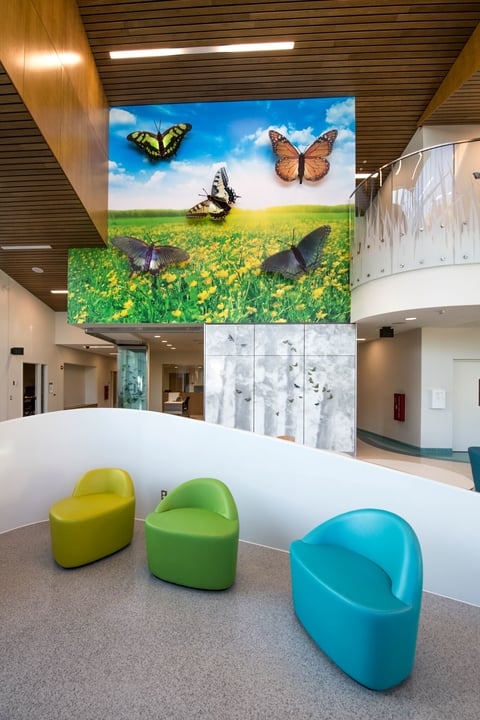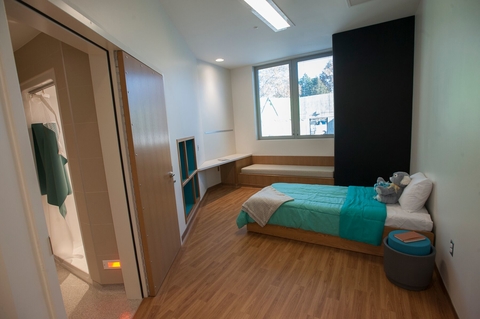Designing a mental health facility for children poses its own challenges compared to designing one for adult patients.
Children process trauma differently. They have different needs than adults. So when Children's Hospital of Richmond at Virginia Commonwealth University decided to undertake a redesign of its behavioral health center—boosting its inpatient bed count from 24 to 32 beds—officials knew it was crucial to incorporate the patient voice throughout the design.
From the earliest planning stages to final details like wall colors and furniture, patients and families were brought in to help, said Alexandria Lewis, director of the Virginia Treatment Center for Children (VTCC).
"Many of them have themselves been traumatized by certain experiences," Lewis said. "One of the things that we wanted to convey to them that this was a welcoming space where they could feel comfortable expressing their feelings and engaging in the healing process."
RELATED: A look inside Lucile Packard's new 521K-square foot 'patient-centered' hospital
The 119,000-square-foot center opened in April and offers an inpatient school program and a "therapy mall" for art, music, recreational and play therapies.
The updated facility also allowed VCU to expand pediatric behavioral health outpatient services and incorporate the Children's Mental Health Resource Center—which helps patients and their families navigate a complex behavioral health system—into the location.
It's part of a broader trend of pediatric hospitals seeking greater input from patients and their families to design spaces that foster healing. For example, the Lucile Packard Children's Hospital Stanford designed its new facility with the goal of improving both the patient and staff experience.

Designing for healing
Many of the patients at VTCC have faced trauma in their past, so hospital officials emphasized choices that would create a welcoming atmosphere, Lewis said.
This included the colors—soothing tones like green, blue and yellow—and the design of a large mural that is just inside the entrance of the facility. The choice of artwork depicting butterflies was deliberate, as the image symbolizes the journey of the patients themselves and was designed with input from the patient and family advisory council, she said.
"It symbolizes transformation and metamorphosis," Lewis said. "They're coming from a cold, dark cocoon and emerging as a butterfly and taking flight."
RELATED: Better hospital design can improve outcomes, patient experience
Other touches to make young patients feel more welcome extend to high ceilings in certain areas that make the space feel more open and courtyards and windows that bring the outside in, Lewis said.
Creating a facility that was supportive of parents was critical, too. The updates brought parking closer to the facility itself, a simple switch that eases a burden on parents, and also include areas where patients' siblings can play and relax.
Individual bedrooms and bathrooms allow for privacy, but inpatient rooms are grouped into pods that allow staffers to monitor them as a group more easily, Lewis said. The rooms can be adjusted to meet a specific patient's needs; for example, the lights can be adjusted and blinds are built into windows for patients who may have light sensitivity.

The rooms are also designed to mitigate potential risk factors for behavioral health patients, including anti-ligature features in case a patient could harm themselves, Lewis said.
RELATED: An 'incredible' $500M donation jump-starts UCSF's plans for a new patient-centered hospital
The day-to-day experience for inpatients is designed to mirror what a typical day outside of the facility would look like. Patients attend classes, meet with their clinicians or spend time with family outside of the room, and eat in a cafeteria like they would at school, Lewis said.
"What we want to do is to reduce any potential trauma they may feel being isolated from their normal routine," she said.
In addition, the facility was designed to be an effective learning environment for the number of trainees that come through, Lewis said.
"We teach ... a whole myriad of behavioral health professionals every single year," she said, "and so the building was also designed to enhance the teaching and learning atmosphere."
Though the facility has only been open for a few months, Lewis said that anecdotally its clinicians report a positive response from patients coming in for treatment.
In outpatient care, for example, therapists say that patients come in with a more positive attitude than before.
"They're walking in happy, and when someone is happy it's easier to engage them," Lewis said. "That engagement then promotes the healing process and the therapeutic process."